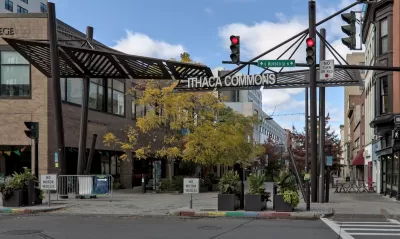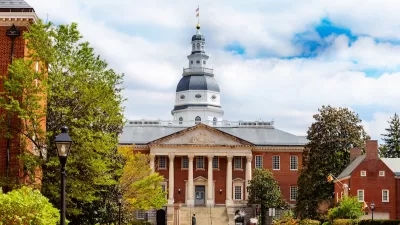This week, Ithaca became the latest city to opt into New York’s new Good Cause Eviction Law. What are tenant organizers doing to make the law work better for their communities?

This article excerpt is reprinted from Shelterforce Magazine.
UPDATED July 19 | In April, New York adopted the Good Cause Eviction Law as part of a long-awaited housing deal in the new state budget, complete with rent increase limits and eviction standards for landlords. Tenant organizers there had been fighting for years to pass a statewide law that would protect renters from excessive rent hikes and unfair evictions.
But organizers say the version of the bill that passed paled in comparison to the legislation that they’d championed, replete with exemptions that leave out millions of renters. Most notably, the new protections only apply to New York City. Municipalities in the rest of the state will have to opt in, leaving more than 2 million upstate New York renters fighting for what some advocates are calling the “Swiss cheese” version of good cause protections.
“Our goal was definitely a statewide mandate,” says Ryan Acuff, education coordinator for the City-Wide Tenant Union of Rochester. “We were never fighting for an opt-in.”
At a glance: New York’s good case eviction law
Katie Sims, co-chair of the Ithaca Tenants Union, says it was “pretty offensive, honestly, to see the state government take this stance that upstate didn’t really need this tenant protection. A huge number of people who live in upstate are tenants, and they need this protection just as much as any other tenant.”
Tenant organizers still celebrate the opportunity to substantially expand tenants’ rights in New York. So far, at least three cities have opted into the state’s good cause law, Ithaca being the most recent.
But tenant organizers in the state face an uneven road ahead to get their municipalities to opt in. Some see the possibility of getting an even stronger good-cause law than the state’s, while others could be left fighting indefinitely to access even those protections.
Opting in
As rental markets outside New York City continue to experience rising prices and housing instability, affordable housing advocates and organizers in upstate New York are trying to seize any and every opportunity to ensure that as many tenants as possible are protected from unsustainable rent increases.
“We see good-cause as a powerful anti-displacement tool in a real estate market like ours that is experiencing rising property values after years of real estate speculation, where landlords refused to make investments and upgrades in rental housing and milked properties for as much value as the market could bear,” said Clarke Gocker, senior director of movement building with PUSH Buffalo, via email. “Those same landlords are ready to cash in.”
But if Buffalo were to opt into the state law, many renters in the city wouldn’t qualify for protection, thanks to a carve-out for owner-occupied buildings, which exempts buildings where owners also reside. “The predominant rental housing typology in the city of Buffalo is the so-called ‘Buffalo double’—two-family, up-and-down rental units built between the late 1800s and early 1900s,” says Gocker. “Many of these are owner occupied and, as a result, would be exempted from Good Cause should the city opt-in.”
Other upstate New York cities, like Albany, Poughkeepsie, Newburgh, Beacon, and Kingston had previously passed good-cause eviction laws, but those were struck down by state courts. Housing advocates and organizers in those cities are trying (some successfully) to get their municipalities to pass a good cause law once again, this time having to adopt what they call a watered-down statewide version, with very little room to adapt it to meet the needs of their municipalities.
For instance, tenants who live in manufactured homes (more commonly known as mobile homes) are exempt from protection. “We’ve really left out a huge swath of upstate New York. And Saratoga County, which is just north of Albany, is the most dense mobile home county in New York State,” says Canyon Ryan, executive director of the United Tenants of Albany. “Almost all low-income homeowners are relegated to these parks, and if you rent your mobile home, then you don’t have these protections, and there’s no way that you can get them.”
But there’s no question that organizers want to get their municipalities to opt in, especially when existing tenant protections are so threadbare, says Sims.
“Upstate New York has so few tenant protections compared to New York City and some of the counties surrounding it that, in a lot of ways, we’re in a completely different regulatory landscape.”
While municipalities can’t change the exemptions for owner-occupied or manufactured housing tenants, there are two components of the statewide version they can amend:
- The maximum fair market rent paid by the tenant before they’re no longer eligible for good cause eviction protection.
- The definition of a small landlord.
In the statewide version of the law, a small landlord is defined as having 10 units or less in their portfolio. (Notably, setting the portfolio size at 10 or less would exempt 52 out of the 54 lawmakers who are landlords themselves, according to a New York Focus investigation). That portfolio size may make sense for New York City, says Sims, but it doesn’t for other municipalities.
“The 10-unit portfolio size exemption that’s in the New York City [version] puts tenants in this awful place where they have to do a lot of digging [on] who exactly owns their buildings and try to find the literal people behind the LLCs,” she says. “There’s so little transparency around that. It’s so hard to find that information.”
[RELATED ARTICLE: How Hidden Property Owners and Bad Landlord Patterns are Revealed in NYC]
That’s why the small landlord component is the most critical, says Ryan of United Tenants of Albany. “We think that the most important thing is to define a small landlord as those with one rental unit in their portfolio, because they can at least, by default, assume that they have the protection.”
Last month, Albany became the first city to opt into the statewide version—setting the portfolio size to one unit, which is encouraging for other municipalities.
“It’s always positive when more upstate municipalities take action,” says Jenna Goldstein, a tenant organizer with For the Many in Kingston and the Hudson Valley. “It’s always going to result in a better domino effect that way.”
Kingston, Poughkeepsie, and Ithaca followed suit this month and opted in, amending their laws to have a portfolio size of one unit. Rochester is expected to deliberate the law in the coming months, and organizers there are hopeful that they, too, will be able to set the small landlord portfolio size to one.
“Anyone who actually wants this protection for tenants has been on board with the portfolio size of one,” says Sims in Ithaca.
But it’s not the same case across all municipalities.
FULL STORY: Read Full Story

Study: Maui’s Plan to Convert Vacation Rentals to Long-Term Housing Could Cause Nearly $1 Billion Economic Loss
The plan would reduce visitor accommodation by 25,% resulting in 1,900 jobs lost.

North Texas Transit Leaders Tout Benefits of TOD for Growing Region
At a summit focused on transit-oriented development, policymakers discussed how North Texas’ expanded light rail system can serve as a tool for economic growth.

Why Should We Subsidize Public Transportation?
Many public transit agencies face financial stress due to rising costs, declining fare revenue, and declining subsidies. Transit advocates must provide a strong business case for increasing public transit funding.

How to Make US Trains Faster
Changes to boarding platforms and a switch to electric trains could improve U.S. passenger rail service without the added cost of high-speed rail.

Columbia’s Revitalized ‘Loop’ Is a Hub for Local Entrepreneurs
A focus on small businesses is helping a commercial corridor in Columbia, Missouri thrive.

Invasive Insect Threatens Minnesota’s Ash Forests
The Emerald Ash Borer is a rapidly spreading invasive pest threatening Minnesota’s ash trees, and homeowners are encouraged to plant diverse replacement species, avoid moving ash firewood, and monitor for signs of infestation.
Urban Design for Planners 1: Software Tools
This six-course series explores essential urban design concepts using open source software and equips planners with the tools they need to participate fully in the urban design process.
Planning for Universal Design
Learn the tools for implementing Universal Design in planning regulations.
City of Santa Clarita
Ascent Environmental
Institute for Housing and Urban Development Studies (IHS)
City of Grandview
Harvard GSD Executive Education
Toledo-Lucas County Plan Commissions
Salt Lake City
NYU Wagner Graduate School of Public Service





























